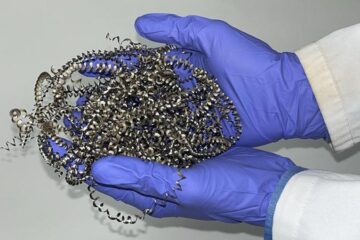Discovery may hold hope for psoriasis sufferers

Scientists at the University of Newcastle upon Tyne, studying the effects of a drug used in the treatment of a distressing skin condition, have found that it is actually killing off the cells which are the cause of the problem.
The team believe the discovery represents a major step towards enabling the design of better treatments for psoriasis, which affects up to a million people in the UK alone (figures from the Psoriasis Association).
The results of the Wellcome Trust-funded study of the drug, dithranol, are published in the Journal of the Federation of American Societies for Experimental Biology (FASEB).
Dithranol, which is widely used in the treatment of psoriasis, is derived from a natural compound, called chrysarobin. Chrysarobin is prepared from the araroba tree found in the rain forests of the Amazon. In India, the same substance is known as Goa powder.
Psoriasis is a genetic condition which, when triggered by certain factors such as injury or throat infection, leads to an over-production of skin cells – called keratinocytes – which causes a thickening of the skin, resulting in the raised red, scaly patches characteristic of psoriasis.
The team of scientists, led by Professor Nick Reynolds and Dr Mark Birch-Machin, of the Skin and Environmental Interactions Research Group in the School of Clinical and Laboratory Sciences at Newcastle University, studied the effects of dithranol – an ointment applied to the surface of the skin – which is used in the treatment of severe cases of psoriasis.
Professor Reynolds says: ’Psoriasis is what is known as a relapsing/remitting condition, which means that sufferers don’t display the symptoms all of the time. Dithranol is a very effective treatment for episodes of psoriasis and it has been around for a long time, since the early 1900s. By studying the action of the drug, we wanted to gain a better understanding of how it works, to give us an insight into the mechanism of the condition.’
Laboratory studies showed that dithranol very quickly targeted skin cells’ mitochondria – the part of a cell from which it draws its energy – causing the cells to die within 24 – 48 hours of the application of the drug, through a process of programmed cell death.
Professor Reynolds continued: ’Although dithranol is a very effective and safe treatment for psoriasis, its widespread use is limited because it is quite difficult to use and causes dark brown stains on clothing and bedding. Also, if it is not used properly, it can cause irritation or burning to the skin around the affected area, so it is most commonly used in hospitals, where the application of the ointment can be overseen by a nurse.’
Most people suffering an episode of psoriasis that requires treatment with dithranol therefore have either to attend hospital as an outpatient five days a week for a six week course of treatment, or be admitted for a three-week period.
’In modern life, this is far from ideal’, says Professor Reynolds. ’These findings represent an important step towards the development of better-designed treatments for psoriasis sufferers’.
Gladys Edwards, Chief Executive of the Psoriasis Association said: ’The Psoriasis Association welcomes these new research findings. It is so important to develop new, effective and safe treatments for psoriasis and this research is clearly a positive step forward’.
PSORIASIS FACTFILE (information from the Psoriasis Association)
Psoriasis is a recurrent skin condition caused by an acceleration of the usual replacement processes of the skin. Normally a skin cell matures in 21 to 28 days during its passage to the surface where a constant invisible shedding of dead cells, as scales, takes place. Psoriatic cells, however, are believed to turn over in two to three days and in such profusion that even live cells reach the surface and accumulate with the dead cells in layers. Psoriasis affects both sexes equally. It may appear for the first time at any age, although it is more likely to appear between the ages of 11 and 45.
Psoriasis appears as raised red patches of skin covered with silvery scales. It can occur on any part of the body although elbows, knees and the scalp are usual sites.
Certain genes have been identified as being linked to psoriasis. It appears, however, that a genetic tendency needs to be triggered off by such things as injury, throat infection, certain drugs and physical and emotional stress. Research is under way into all aspects of the causes of psoriasis.
There are a variety of topical treatments available i.e. creams and ointments that are applied to the skin. When used properly they can be most effective and have minimal side effects.
Media Contact
More Information:
http://www.ncl.ac.ukAll latest news from the category: Health and Medicine
This subject area encompasses research and studies in the field of human medicine.
Among the wide-ranging list of topics covered here are anesthesiology, anatomy, surgery, human genetics, hygiene and environmental medicine, internal medicine, neurology, pharmacology, physiology, urology and dental medicine.
Newest articles

“Nanostitches” enable lighter and tougher composite materials
In research that may lead to next-generation airplanes and spacecraft, MIT engineers used carbon nanotubes to prevent cracking in multilayered composites. To save on fuel and reduce aircraft emissions, engineers…

Trash to treasure
Researchers turn metal waste into catalyst for hydrogen. Scientists have found a way to transform metal waste into a highly efficient catalyst to make hydrogen from water, a discovery that…

Real-time detection of infectious disease viruses
… by searching for molecular fingerprinting. A research team consisting of Professor Kyoung-Duck Park and Taeyoung Moon and Huitae Joo, PhD candidates, from the Department of Physics at Pohang University…





















